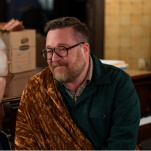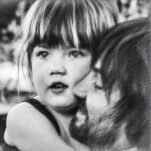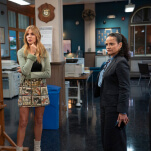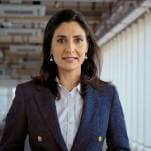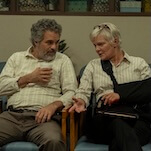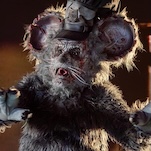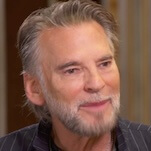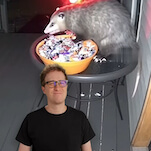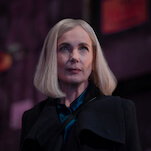While revitalizing a seemingly bygone period of TV, that of the multi-cam-with-a-moral storytelling honed by co-executive producer Norman Lear, One Day At A Time has also bucked modern convention by crafting standalone stories that are as rewarding and enjoyable as season-long arcs. You can and should watch the show from the beginning, but every episode offers an entry point, whether it’s the modern-dating woes of “A Snowman’s Tale,” the ride-or-die bond between siblings in “What Happened,” or the familial free-for-all that is the season-three opener, “The Funeral.” (Come for the Gloria Estefan and Rita Moreno duet, stay for Brooklyn Nine-Nine stars Stephanie Beatriz and Melissa Fumero as members of the extended Alvarez family.)
That the self-contained storylines work as well as the more expansive ones is in great part thanks to the prioritization of character over plot, yet another area in which ODAAT is ahead of the curve. Penelope “Lupe” Alvarez (Machado) is a single mother, an Iraq War vet, a nurse, and someone in therapy for her depression and anxiety; she’s also first-generation Cuban-American, overprotective, ambitious, guilt-ridden, and a bit of a dork. So no matter what the circumstances are—say, a run-in with a misogynistic co-worker or a chance at new love—we not only have a sense of how Penelope will handle them, but we care a whole lot about how she’s affected. ODAAT’s consideration for both character and story has pushed the boundaries of what a streaming series can be: both good-hearted and just plain good (well, great).
Season three, which premieres today on Netflix, continues that development while adding a few new players to the mix: We finally meet Tito (a very suave Danny Pino), Penelope’s Cubanazo brother who can do no wrong in Lydia’s (Moreno) eyes, but gets called to account by series writers Becky Mann and Audra Sielaff in episode four. Though Dr. Berkowitz’s (Stephen Tobolowsky, game as ever to marvel at the EGOT winner in the cast) horrid daughters remain unseen, the show fleshes out their relationship a bit more. Elsewhere, Schneider (Todd Grinnell, who also directs the eighth episode) brings his dad (Alan Ruck) home to meet a new girlfriend (India de Beaufort, Grinnell’s real-life spouse) and the real loves of his life, the Alvarezes. True Blood alums Ed Quinn and Joe Manganiello also make guest appearances that have varying effects on Penelope. And of course, there’s the trio of Estefan, Beatriz, and Fumero, who are, respectively, in the immediately recognizable roles of rival sibling, prima hermana, and the cool cousin who’s everything you want to be when you (or rather, Isabella Gomez’s Elena) grow up.
As for our core ensemble, Penelope is still struggling to balance work, school, family, and a personal life (she gets help with the latter from Alex Quijano’s Mateo). Elena is as nerdy and earnest as ever, cheering for esports teams and dragging her “Syd-nificant other” Syd (Sheridan Pierce) to rallies and 5K fundraisers on dates, while Alex (Marcel Ruiz) remains his sister’s polar opposite and his grandmother Lydia’s best friend. But the third season—which features the usual host of writers and directors, including Calderón Kellett, Royce, Dan Hernandez, Debby Wolfe, and Phill Lewis—respects the growth we’ve seen and complicates every one of these relationships. Elena is proudly out and more comfortable than ever, but that doesn’t mean her peers or even her father Victor (James Martinez) are any more accepting. For the first time, Alex keeps secrets from Lydia, who finally lets down her guard around Elena, resulting in some of the most poignant moments of the series. And though Penelope initially continues to hide her depression and anxiety from her children, she soon questions just whom she’s protecting with her secrecy.
ODAAT has long since perfected its mix of in-the-moment humor and issues-based storytelling, so we get great visual gags (think Dr. B posing as a matador for Lydia) and gentle teasing about baby queer Elena’s boundless enthusiasm—which culminates in the wearing of a “heart-butt” hat—along with heartfelt moments of discovery and vulnerability, like when Penelope has visions of her late father Berto (Tony Plana), who, in one of the most Cuban moments, is still trying to help his daughter be happy from beyond the grave. The larger themes the show has been developing, including how Latinx folks and Latin American immigrants navigate this increasingly unrepentantly xenophobic country, are even more seamlessly woven into the episodic action. Calderón Kellett and her writers wisely afford nothing more than a few sly jokes at the expense of the festering apricot who doesn’t understand the most basic of architectural concepts, but they do highlight the casual racism of New Age performative do-gooders and wealthy absentee fathers. And ODAAT’s ongoing explorations of mental health, different types of masculinity, as well as cultural heritage come into sharper relief while never once coming across as having an agenda.
Now here’s where the “challenging” part comes in—by centering on a multi-generational, multi-cultural, and multi-household family, ODAAT is making viewers rethink what they consider realism in their TV shows. Instead of the whitewashed Los Angeles too often seen in TV and movies, the demographic make-up of the show is much closer to reality, with characters who are Latinx, white, black; queer and straight; non-binary; able-bodied and disabled; poor, middle-class, rich; conservative, liberal, and progressive. (It’s still a mostly sanitized version of the second largest city in the country, but this is a sitcom.) And though we’re always aware of their Cuban heritage—Lydia and her bandera would never let us forget—their experiences manage to be both specific and all-encompassing. There are overbearing mothers and overachieving siblings; single parents and aging parents; recovering addicts and veterans with PTSD; three generations under one roof as well as multiple found families. This is it: representation and realism; a family like yours and also different from yours, but no less valid.
